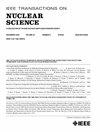Comparison of Proton Irradiation Effects on Electrical Properties of Quasi-Vertical and Lateral GaN Schottky Barrier Diodes
IF 1.9
3区 工程技术
Q3 ENGINEERING, ELECTRICAL & ELECTRONIC
引用次数: 0
Abstract
In this article, quasi-vertical and lateral gallium nitride (GaN) Schottky barrier diodes (SBDs) with similar electrical parameters are irradiated with 200-keV protons at different fluences. The radiation-induced defects induced by irradiation affect carrier concentration and tunneling current, result in a slight decrease in the forward current and an increase in the reverse current of quasi-vertical GaN SBDs. In contrast, lateral GaN SBDs exhibit significant degradation in forward current characteristics and a reduction in reverse current postirradiation. Electrical parameter variations in the N质子辐照对准垂直和侧向GaN肖特基势垒二极管电性能影响的比较
本文用200 kev质子辐照具有相似电参数的准垂直和横向氮化镓肖特基势垒二极管(sdd)。辐射诱导缺陷影响载流子浓度和隧穿电流,导致准垂直GaN sdd的正向电流略有下降,反向电流略有增加。相比之下,横向GaN sdd在正向电流特性和反向电流的辐射后减少方面表现出明显的退化。通过C-V、传输线模型(TLM)和霍尔测量,分析了准垂直sdd中N $^{-}$ -GaN和N+-GaN层的电参数变化,以及侧向二极管中AlGaN/GaN异质结界面上二维电子气(2DEG)浓度的变化。通过结合离子在物质中的停止和范围(SRIM)和技术计算机辅助设计(TCAD)模拟,对两种GaN sdd中辐射诱导缺陷的类型和分布进行了建模,以全面揭示质子辐照下两种器件的降解机制。
本文章由计算机程序翻译,如有差异,请以英文原文为准。
求助全文
约1分钟内获得全文
求助全文
来源期刊

IEEE Transactions on Nuclear Science
工程技术-工程:电子与电气
CiteScore
3.70
自引率
27.80%
发文量
314
审稿时长
6.2 months
期刊介绍:
The IEEE Transactions on Nuclear Science is a publication of the IEEE Nuclear and Plasma Sciences Society. It is viewed as the primary source of technical information in many of the areas it covers. As judged by JCR impact factor, TNS consistently ranks in the top five journals in the category of Nuclear Science & Technology. It has one of the higher immediacy indices, indicating that the information it publishes is viewed as timely, and has a relatively long citation half-life, indicating that the published information also is viewed as valuable for a number of years.
The IEEE Transactions on Nuclear Science is published bimonthly. Its scope includes all aspects of the theory and application of nuclear science and engineering. It focuses on instrumentation for the detection and measurement of ionizing radiation; particle accelerators and their controls; nuclear medicine and its application; effects of radiation on materials, components, and systems; reactor instrumentation and controls; and measurement of radiation in space.
 求助内容:
求助内容: 应助结果提醒方式:
应助结果提醒方式:


